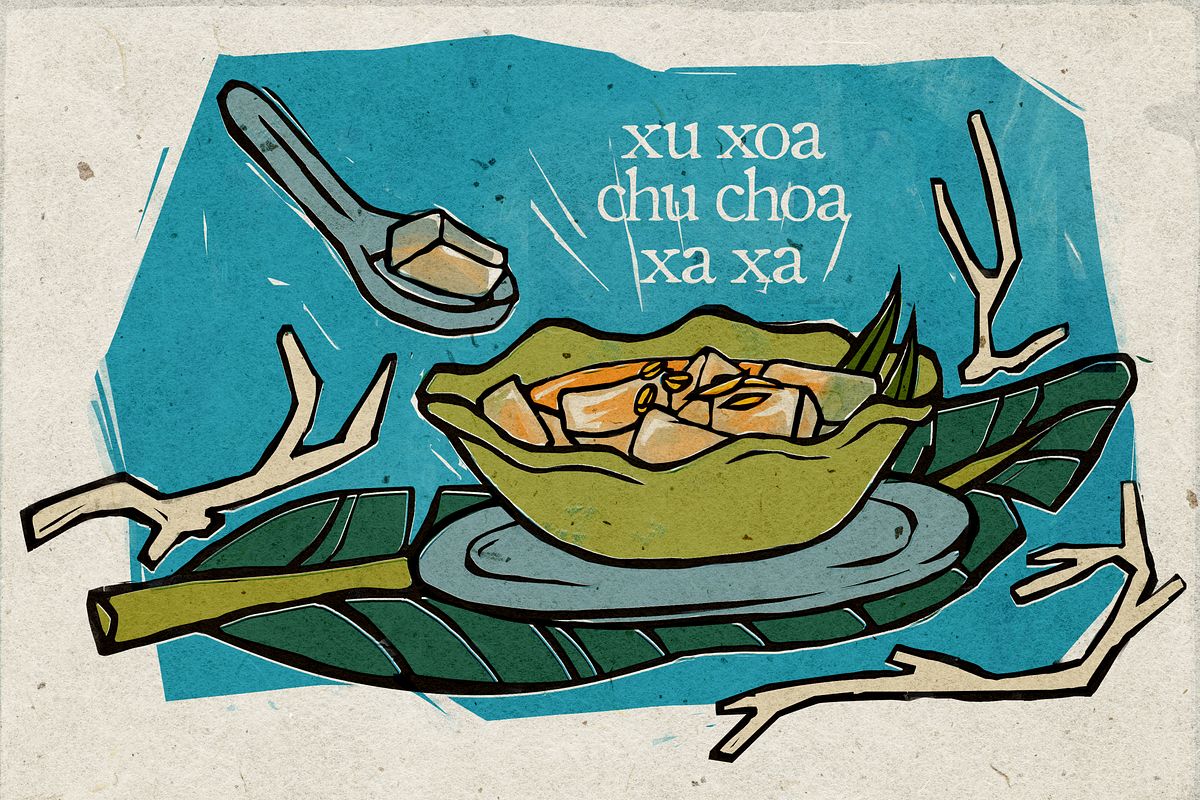If Saigoneers often turn to sương sâm (leaf jelly) or sương sáo (grass jelly) as refreshments on hot days, the choice of residents of provinces along the central coast is xu xoa. Chunks of translucent, lightly umami jelly swim in the sweetness of a ginger-flavored sugar syrup — a perfect snack that cools the body.
Xu xoa has many different iterations in terms of name: xu xa, xa xa, xoa xoa or chu choa. Despite the numerous nicknames, xu xoa from Quảng Bình to Bình Thuận is made from the same key ingredient. It’s a species of seaweed commonly found living on wet boulders and reefs along the sea. Locals refer to it as rong câu or rau đông.
Rong câu grows in bushes that attach themselves onto the rock surface, each strand is willowy and opaque like the skeletons of small fish. Spring is the seaweed’s most robust growth period, and harvesting can begin as soon as the lunar March, stretching until the lunar July. During this time, villagers head to the beach to pluck off rong câu to sell in markets.

At low tide, usually in the early morning or early afternoon, dredgers arrive at big boulders with scrapers and bamboo baskets. Rocks of various sizes are covered in a colorful veil of seaweed, from emerald green, ochre to ivory. With rolled up pants and giant hats, harvesters work tirelessly under the searing sun and salty winds to collect the freshest seaweed possible to make a living. First, they lodge the tip of the scraper deep into the boulder grooves, then push the whole seaweed out, roots included. The baskets are full after a few hours. The work only finishes when the tide rises again and everyone has their bounty — half a kilo if you’re unlucky and up to a few kilos if you’re fortunate.
Cleaning and cooking xu xoa are no less strenuous compared to harvesting its main ingredient. The seaweed often carries lots of debris and sand, which need to be picked out, while the plant itself must be washed thoroughly to remove the fishiness and saltiness. After the wash, usually half of the rong câu is used to make xu xoa while the other half is sun-dried. The heat during noon is the best for this task, and after a few days under the sun, the seaweed shrivels up, turning a deep shade of brown like coconut husks. This dry version is kept at home to make xu xoa during off seasons or transported away to factories and markets.

The creation of the actual dessert is not as complicated. Fresh rong câu is boiled in a pot with water. Afterwards, with a squeeze of lime juice, the seaweed disintegrates more easily. The acidity in the lime helps denature the coagulant in the seaweed. When the plant has completely melted into the water, the liquid is finally strained to become xu xoa extract. Once cooled, the extract congeals again into a jiggly block of jelly.
Now that the jelly is done, the next step involves making the ginger syrup. The sweetener of choice is usually brown sugar, a refined sugar with added molasses. Quảng residents opt for cane sugar blocks. The water is heated until bubbling to add the sugar. The longer the boil, the thicker the syrup. Experienced home cooks can immediately tell if the syrup is ready by its viscosity. If precision is desired, a refractometer is required. While the sugar is bubbling away, freshly diced ginger is added. Depending on personal taste, young or old ginger bulbs are chosen.

The scent of sweet ginger always gives xu xoa away. Gaggles of kids playing in the front yard immediately drop everything upon catching a whiff to run down to the kitchen to check if mom is making xu xoa. It’s the one snack that remains close to the hearts of children of Central Vietnam, like how author Kim Em describes in the book Ăn để nhớ (Eating as Reminiscing): “My mother didn’t want us to skip out on our afternoon naps to play in the sun, so she would promise that if we took our naps, she would give us some money to buy xu xoa after we woke up. Of course, I would lie down on the settee, close my eyes, and pretend to sleep while dreaming about a bowl of gingery, sugary xu xoa from the mobile xu xoa lady.”

Street xu xoa is a distinctive feature of the Central Vietnam summer, showing up on the bamboo yokes of old ladies or the backseats of bike vendors. They call out: “Ai xu xoa hông? / Who wants xu xoa?” The vendors are often all too eager to give us a flashy knife show as they quickly eviscerate the giant pot-sized block of jelly into uniform chunks of sparkling xu xoa, before ladling on a layer of fragrant ginger syrup. Holding a bowl of xu xoa in my hands is like cradling a midsummer oasis, one that I always have to spend a few moments admiring before slowly relish every bit, as Kim Em aptly writes: “I wasn’t in a hurry to eat it because I was afraid that summer would vanish right on my tongue.”
Apart from the classic ginger syrup, there are a number of different ways to enjoy xu xoa. Chè shops in Đà Nẵng have a xu xoa version that includes xu xoa, mung bean paste, red pearls, bánh lọt, black beans, and decadent coconut milk. In Hội An, vendors often advertise xa xa and lường phảnh. Xa xa is their version of xu xoa, while lường phảnh is a black jelly made from a local herbal leaf and traditional medicinal herbs.

Xu xoa is not just an excellent protector against the heat of summer, it’s also a remedy for homesickness for Vietnamese from the central region. In Saigon, every time they miss home, they would head to Bà Hoa Market for a bowl of gingery xu xoa or a bag of dry rong câu to recreate the flavors at home. Xu xoa’s pleasant sweetness is like an embrace, abating a yearning for a distant land, if only for a moment.

















